Effectively managing your time involves deliberately planning and controlling how much time you dedicate to various tasks. This strategic approach aims to boost overall effectiveness, enhance efficiency, and ultimately increase productivity. True time management involves self-management and prioritising, not just watching the clock. This encompasses setting goals, prioritising tasks, scheduling activities, and eliminating time-wasting distractions.
In personal contexts, effective time management can lead to a less stressful lifestyle, allowing individuals. To pursue hobbies, spend time with loved ones, and maintain a healthier balance.
In professional settings, it is a critical skill for meeting deadlines, managing projects, and achieving career objectives. Ineffective time management leads to lost opportunities, elevated stress levels, and reduced fulfilment in one’s work. Essentially, effective time management boils down to consciously deciding how to allocate our most valuable asset: time.
- Overview of the Visual Timeline
- Understanding Time Management
- The Role of a Visual Timeline in Time Management
- Components of Effective Time Management
- Prioritization Techniques
- Creating a Visual Timeline for Effective Time Management
- Step-by-Step Guide to Building the Timeline
- Time Management Techniques for Mastery
- Evaluating and Adjusting Time Management Strategies
- Conclusion
Overview of the Visual Timeline
A visual timeline serves as a powerful tool for visualising and organising time management strategies. By representing time-sensitive tasks and milestones in a graphical format, individuals can gain a clearer understanding of their schedules, deadlines, and project dependencies. This visualisation can range from simple linear timelines to more complex charts and diagrams. The timeline can incorporate various elements such as start and end dates, task durations, progress indicators, and colour-coding to categorise activities.
Utilising a visual timeline helps in identifying potential conflicts or overlaps in schedules, allowing for better resource allocation and adjustments as needed. Whether used for personal planning, project management, or strategic planning, a visual timeline facilitates clarity and provides a strategic overview, making it easier to adhere to schedules and track progress towards goals. This tool proves especially useful in complex projects or when managing multiple commitments simultaneously.
Importance of Mastering Time Management
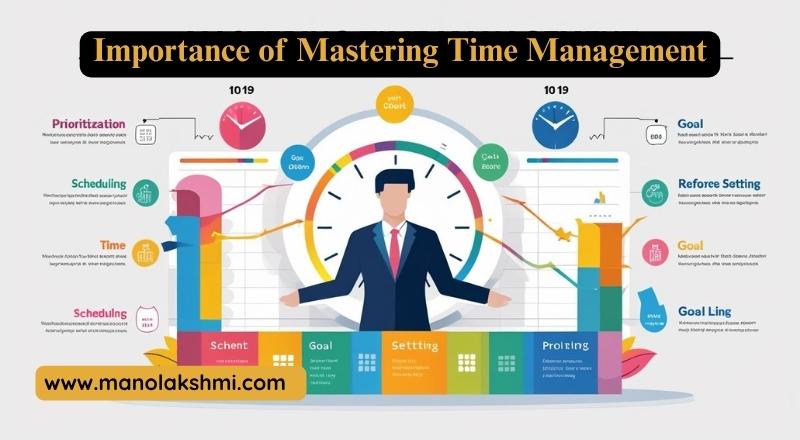
Mastering time management yields a plethora of benefits that significantly enhance both personal and professional life. At the forefront is increased productivity. When individuals effectively manage their time, they can accomplish more within a given period. This efficiency often leads to better quality work as tasks are completed with focus and minimal distractions. Secondly, mastering time management significantly reduces stress. Having tasks planned reduces anxiety, provides control over one’s schedule, and prevents feeling overwhelmed or rushed.
Balancing work duties, recreation, and personal interests prevents exhaustion and leads to a satisfying way of life through the proper management of time. Other benefits include improved decision-making, enhanced organisational skills, and increased opportunities for personal and professional growth. Ultimately, becoming proficient in time management is not just about optimising productivity but about creating a more balanced, fulfilling, and successful life.
Understanding Time Management

Effective time management is a crucial skill for achieving personal and professional goals. It involves a conscious effort to organise and plan the time spent on specific activities, ultimately increasing productivity and reducing stress.
Key Concepts of Time Management
Strong time management is built upon a set of fundamental principles.
Prioritisation: Categorisation of tasks is determined by urgency and importance. Employing methods like the Eisenhower Matrix (urgent/important) can help individuals focus on high-impact activities first. Ensuring that critical deadlines are met and significant goals are addressed effectively. Prioritisation prevents time from being disproportionately spent on less important or trivial tasks.

Goal Setting: Well-articulated, attainable objectives offer both guidance and impetus. SMART criteria (Specific, Measurable, Achievable, Relevant, Time-bound) ensure well-structured goals and effective planning. Transforming ambitious goals into smaller, actionable tasks reduces their complexity and promotes better scheduling integration.
Planning and Scheduling: This involves creating a roadmap for how time will be allocated to various tasks and activities. Effective planning includes identifying necessary steps, estimating the time required for each, and scheduling them within a defined timeframe. Various tools, such as calendars, to-do lists, and digital planning applications, can aid in this process. Scheduling helps in visualising commitments and ensuring a balanced allocation of time.
Common Time Management Challenges

Despite understanding the principles, individuals often encounter obstacles that hinder effective time management:
Procrastination: This is the act of delaying or postponing tasks, often leading to missed deadlines and increased stress. Procrastination can stem from various factors, including fear of failure, perfectionism, or lack of motivation. Identifying the root causes of procrastination is the first step towards overcoming it, potentially through techniques like breaking tasks into smaller steps or using the Pomodoro Technique.

Distractions: In today’s environment, distractions are pervasive, ranging from digital notifications and social media to interruptions from colleagues or family. Minimising distractions requires conscious effort, such as creating a dedicated workspace, turning off notifications, and setting boundaries. Effectively managing distractions is crucial for maintaining focus and productivity.
Overcommitting and Poor Prioritisation: Saying “yes” to too many commitments can lead to feeling overwhelmed and stretched thin. This often stems from a difficulty in assessing one’s capacity or a lack of clear priorities. Learning to say “no” to non-essential tasks and effectively prioritising commitments based on values and goals is essential for sustainable time management. Poor prioritisation, as mentioned earlier, can also lead to time being spent on low-value activities while important tasks are neglected.
The Role of a Visual Timeline in Time Management
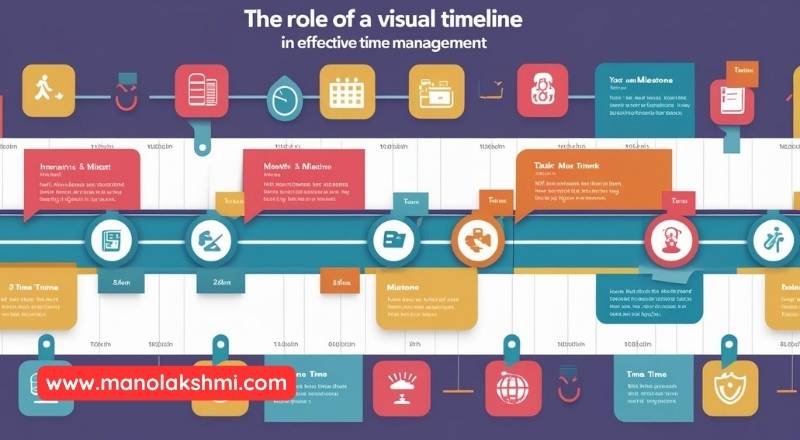
Visual aids play a significant role in enhancing the effectiveness of time management by improving the understanding and retention of key concepts and planned activities:
Enhanced Understanding: Visual timelines, such as Gantt charts, project calendars, or even simple handwritten schedules, provide a clear and graphical representation of tasks, deadlines, and progress. This visual format can make complex schedules easier to comprehend at a glance compared to text-heavy lists. Seeing the entire timeline allows individuals to understand the sequence of tasks, dependencies between them, and the overall project duration.
Improved Retention: Visual information is generally processed and retained more effectively. By the human brain than purely textual information. A visual timeline allows individuals to internalise their schedule and commitments more readily. The visual cues and spatial arrangement of tasks on a timeline can create stronger memory anchors, making it easier to recall deadlines and upcoming activities without constantly referring to a written list. This enhanced retention contributes to proactive planning and reduces the likelihood of overlooking important tasks or deadlines.
Components of Effective Time Management
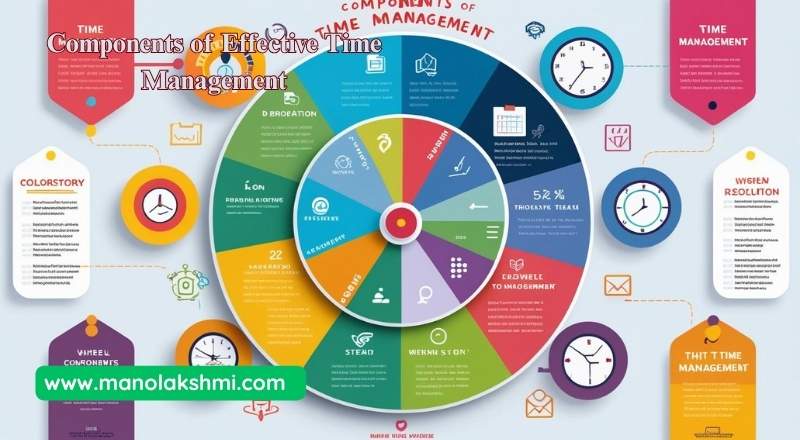
Effective time management is a multifaceted skill that involves a conscious and systematic approach to utilizing one’s time productively and efficiently. It’s not merely about doing more things, but about doing the right things at the right time. Several key components contribute to mastering time management, and understanding these elements is crucial for enhancing personal and professional effectiveness.
Identifying and Setting Goals
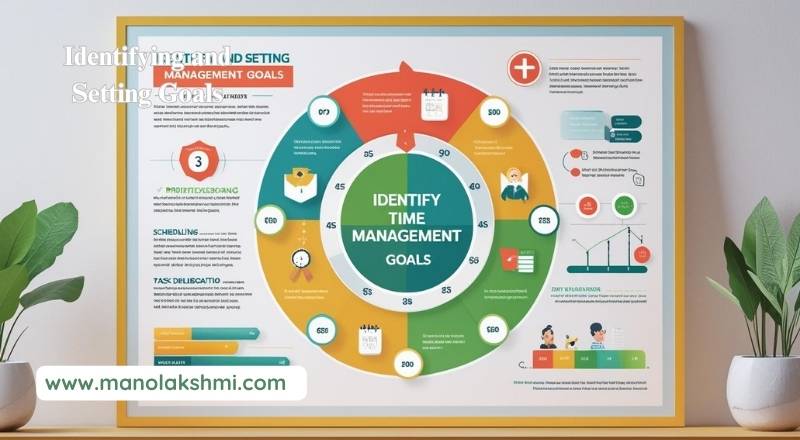
The foundation of effective time management lies in clearly defining what you want to achieve. Lacking established objectives, endeavors may become fragmented and lose focus. This is where the principle of SMART goals becomes invaluable.
Importance of SMART goals: SMART is an acronym that provides a framework for setting effective and attainable goals:
Specific: Clarity is key to goal setting. Rather than a broad aim like “improve fitness,” opt for a clearly stated objective such as “reduce weight by 5 kg by July 31st.” Specificity eliminates any confusion or vagueness.
Measurable: Progress can be tracked and achievement determined with a measurable goal. Using quantifiable metrics makes it easy to assess success. For example, instead of “learn Spanish,” a measurable goal would be “complete the first three units of a beginner’s Spanish course.”
Achievable: With consideration of your current resources, timeframe, and capabilities, an achievable goal is both realistic and attainable. While it’s important to challenge yourself, setting goals that are impossible to reach can lead to demotivation. For improved achievement, it’s recommended to divide significant objectives into smaller, actionable tasks.
Relevant: An effective goal harmonizes with your encompassing objectives, core values, and top priorities. It should be something that truly matters to you and contributes to your overall success and fulfillment. Asking yourself, “Why is this goal important?” can help determine its relevance.
Time-Bound: With a set deadline, a time-bound goal instills urgency and delivers a defined completion timeframe. This approach discourages delay and aids in sustained concentration. For instance, instead of “write a book,” a time-bound goal would be “complete the first draft of my book manuscript within the next 12 months.”
Prioritization Techniques
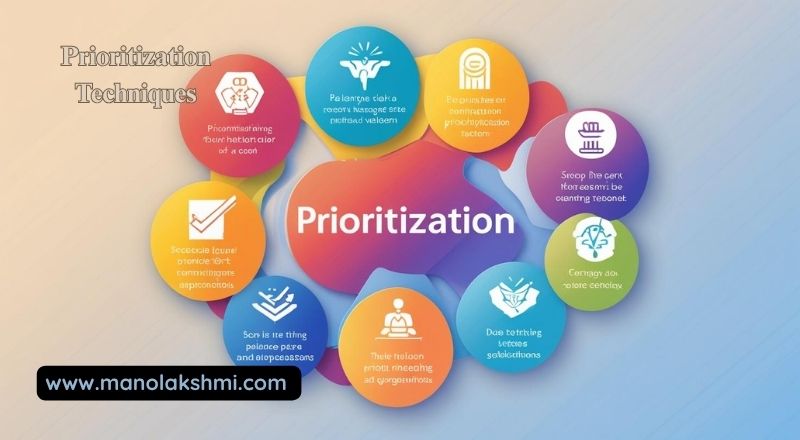
Once goals are established, the next critical step is determining. Which tasks and activities are most important and require immediate attention. Effective prioritization ensures that you focus your time and energy on high-impact activities. Rather than getting bogged down by less significant ones. Several techniques can aid in this process:
The Eisenhower Matrix (urgent vs. important): This efficient system organizes tasks into four distinct categories. These categories are determined by evaluating both the urgency and importance of each task.
Quadrant 1: Urgent and Important: Critical tasks demanding prompt action, with serious outcomes at stake. Examples include dealing with a crisis, meeting a critical deadline, or addressing a pressing health issue. These tasks must be executed promptly without any delay.
Quadrant 2: Not urgent but important: Although not instant, activities are crucial for attaining long-term success and promoting personal growth. Examples include planning, building relationships, learning new skills, and preventive maintenance. These tasks should be scheduled and proactively managed.
Quadrant 3: Urgent but Not Important: These tasks often involve interruptions, meetings requested by others, or less significant administrative tasks. While they may feel pressing, they do not contribute significantly to your key goals. These tasks should be delegated if possible or minimized.
Quadrant 4: Not Urgent and Not Important: These are often time-wasting activities that provide little to no value. Examples include excessive social media browsing or engaging in unproductive distractions. These tasks should be eliminated or significantly reduced.
ABC prioritization method:
Tasks are classified into three priority levels using this method.

A – High Priority: Critical tasks demand immediate attention, as their completion is essential for achieving your objectives. Prioritize and address these impactful items first.
B – Medium Priority: These tasks are important but not as critical as A-level tasks. They should be addressed after the A-level tasks are completed.
C – Low Priority: These tasks have a low priority and exert minimal influence on your objectives. You may delegate or defer them as needed.
Planning and Scheduling

With clear goals and a sense of priority, the next step is to create a structured plan and schedule to allocate time effectively. This involves organizing tasks and commitments into a manageable framework.
Daily, weekly, and monthly planning frameworks: Establishing regular planning routines at different time horizons helps maintain focus and track progress.
Daily Planning: At the start or end of each day, review your tasks, prioritize them, and allocate specific time slots for their completion. The above outlines a structured plan for the day. It offers a detailed itinerary designed to streamline activities.
Weekly Planning: At the beginning of each week, review your weekly goals and schedule key tasks and appointments. This helps ensure that your daily activities contribute to your broader objectives.
Monthly Planning: Monthly, review your progress towards longer-term goals, adjust your plans as needed, and identify key milestones for the upcoming month.
Time blocking and scheduling techniques: These are methods for allocating specific blocks of time for particular tasks or activities in your calendar.
Time Blocking: This involves dividing your day into dedicated blocks of time for specific types of work or individual tasks. For example, you might block out 9:00 AM to 11:00 AM for writing reports and 2:00 PM to 3:00 PM for responding to emails.
Scheduling: This involves assigning specific start and end times for individual tasks or appointments in your calendar. This provides a more detailed and structured approach to managing your time.
Creating a Visual Timeline for Effective Time Management
A visual timeline serves as a powerful tool for enhancing time management skills by providing a clear graphical representation of tasks, deadlines, and progress. This visual approach can significantly improve organization, productivity, and the ability to meet objectives promptly.
Designing the Visual Timeline
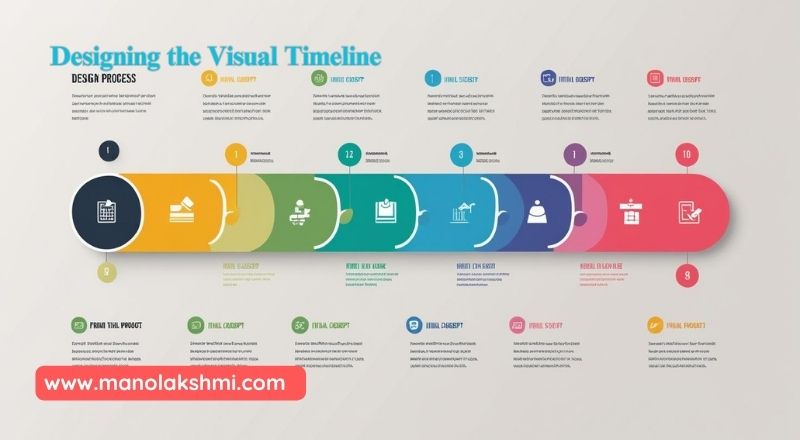
The initial stage involves careful consideration of the timeline’s design, ensuring it effectively communicates the necessary information.
Choosing the right format (digital vs. paper): Choosing the optimal timeline format is the initial step. A paper-based timeline offers a tangible and easily accessible overview, ideal for individuals who prefer a physical representation and manual updates. It can range from a simple handwritten schedule to a more structured printed template.
Conversely, a digital timeline, created using software or applications, provides greater flexibility for editing, sharing, and integration with other digital tools.
Digital formats often offer features such as automated reminders, color-coding, and the ability to easily adjust deadlines and task durations. The choice between digital and paper depends on individual preferences, the complexity of the project, and the need for collaborative access.

Goals, Deadlines, Milestones, tasks. A well-designed visual timeline should incorporate several essential elements. To provide a comprehensive overview of the project or period being managed.
The timeline’s Goals define its main objectives. These should be clearly stated and visible to guide all tasks and deadlines.
Deadlines are fixed dates for completing tasks or goals, and they should be clearly marked on a timeline.
Milestones mark key deliverables and significant checkpoints throughout the timeline. They represent progress towards the overall goals and help to break down larger projects into more manageable segments.
Achieving goals and milestones necessitates specific, actionable tasks. Each task should be clearly defined and placed on the timeline according to its start and end dates.
Step-by-Step Guide to Building the Timeline

Constructing a visual timeline involves a systematic approach to ensure all necessary information is captured and organized effectively.
Step 1: List all tasks and responsibilities: First, conduct a thorough brainstorming session to identify and list all tasks and responsibilities required to be completed within the specified period.
This may involve breaking down larger goals into smaller, more manageable actions. It is crucial to be as thorough as possible at this stage to avoid overlooking any necessary steps.
Step 2: Establish priorities and deadlines: Once all tasks are listed, the next step is to determine the priority of each task and establish realistic deadlines for their completion. Prioritization can be based on factors such as urgency, importance, and dependencies between tasks. Tasks must have achievable deadlines, reflecting the estimated time needed for each.
Step 3: Craft a schedule outlining the duration of each task: This is the central action in developing the graphical timeline. Each task should be placed on the chosen timeline format, indicating. Its start and end dates based on the established priorities and deadlines. The visual representation allows for a clear understanding of the project’s duration and the sequence of tasks. For digital timelines, this often involves dragging and resizing task bars, while paper-based timelines may involve drawing lines or filling in sections to represent task durations.
Step 4: Review and adjust the timeline regularly: A visual timeline is not a static document. Ensure it’s a dynamic resource, routinely assessed and modified. The timeline should be adjusted to reflect current progress or unforeseen setbacks as they arise.Regular review allows for proactive identification of potential bottlenecks and the opportunity to make necessary adjustments to ensure goals remain achievable.
Tools for Creating a Visual Timeline
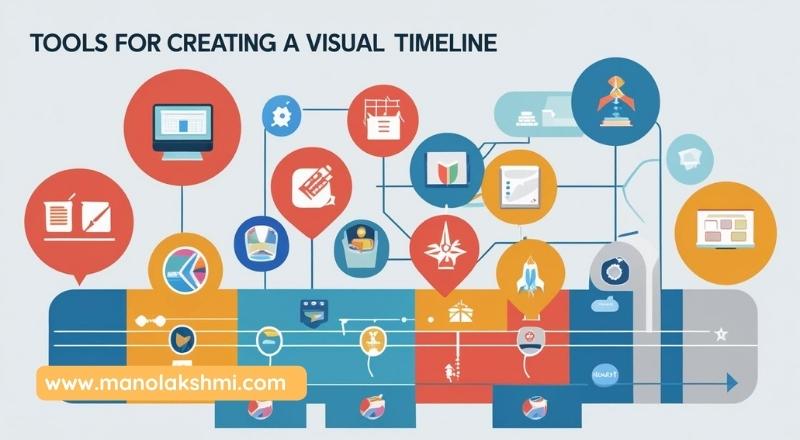
Numerous tools are available to assist in the creation of visual timelines, ranging from simple digital templates to sophisticated project management software.
Recommended software and apps (e.g., Trello, Asana, Gantt chart creators):
A wide array of software and applications are designed specifically for creating and managing visual timelines.
Trello is a flexible, list-based tool that can be adapted to create simple timelines. By organizing tasks into columns representing different stages or periods.
Asana is a more comprehensive project management platform that offers timeline views, allowing users to visualize task dependencies and progress over time.
Gantt chart creators are specifically designed for creating Gantt charts, which are a type of bar chart that illustrates project schedules, showing the start and end dates of tasks, dependencies, and milestones. Many dedicated Gantt chart software options are available, offering advanced features for complex projects.

- Tips for using digital tools effectively: When utilizing digital tools for creating visual timelines, several tips can enhance their effectiveness.
- Utilize color-coding: Assigning different colors to tasks or categories can improve visual clarity and make it easier to identify key activities.
- Set reminders and notifications: Many digital tools offer features to set reminders for upcoming deadlines, helping to ensure the timely completion of tasks.
- Collaborate and share: Digital timelines facilitate collaboration by allowing multiple team members to view and update the timeline, promoting transparency and accountability.
- Customize views: Explore the options for customizing the timeline view to focus on specific timeframes or task categories.
Time Management Techniques for Mastery

Effective time management is essential for improving objectives. Several effective techniques can be employed to gain control over your schedule and optimize your workflow.
The Pomodoro Technique
The Pomodoro Technique is a time management method that breaks down work into focused intervals, traditionally 25 minutes in length, separated by short breaks (typically 5-10 minutes). This methodical approach aids in sustaining and mitigating burnout.

Explanation of timed work intervals and breaks: The core of the Pomodoro Technique lies in its cyclical structure. A “Pomodoro” refers to a focused 25-minute work session on a specific task, followed by a brief break. The strict time limits create a sense of urgency and encourage focused work. The short breaks allow for mental refreshment, preventing fatigue and maintaining engagement. The longer breaks after four Pomodoro’s provide an opportunity to step away from the work entirely, further aiding in preventing mental exhaustion and promoting sustained productivity over longer periods. The defined structure minimizes distractions and promotes a rhythm of focused effort and necessary rest.
The Two-Minute Rule

The Two-Minute Rule is a simple yet powerful principle for tackling small tasks. It states that if a task takes less than two minutes to complete, you should do it immediately rather than postponing it. This helps to prevent the accumulation of minor tasks that can collectively become overwhelming.
How to tackle small tasks immediately: When a small task arises, such as replying to a quick email, filing a document, or making a brief phone call, the Two-Minute Rule suggests addressing it right away. This immediate action prevents these small items from lingering on your to-do list and consuming mental energy. Completing tasks quickly boosts momentum and productivity, reduces mental clutter, and enhances efficiency by preventing minor responsibilities from escalating.
Delegation and Outsourcing

Delegation and outsourcing are essential time management strategies that involve entrusting tasks to others. Effective delegation frees up your time for higher-priority activities and allows you to leverage the skills and expertise of others. Outsourcing entails engaging external individuals to perform designated tasks or responsibilities.
Importance of delegating tasks to manage time effectively: Recognizing which tasks can be effectively handled by others is a crucial aspect of time management. Delegating appropriately not only reduces your workload but also empowers team members and fosters their development. By entrusting tasks to capable individuals, you can concentrate on activities that require your unique skills and attention, maximizing your overall productivity.
Furthermore, distributing responsibilities can lead to improved efficiency and innovation, as different individuals may bring varied perspectives and approaches to the tasks. Learning to delegate effectively is a hallmark of strong leadership and a key strategy for optimizing personal and team performance.
Evaluating and Adjusting Time Management Strategies
Effective time management is not a static skill but rather an ongoing process that necessitates continuous evaluation and refinement. Regularly assessing your strategies allows you to identify what works, pinpoint areas for improvement, and ultimately enhance your productivity and achieve your goals more efficiently.
Tracking Time and Productivity
![]()
Efficient time management relies heavily on self-assessment and detailed time logging. Understanding how you currently spend your time is crucial for identifying time-wasting activities, recognizing peak productivity periods, and making informed decisions about allocating your resources. Consistent time tracking allows you to understand your workflow better, providing data on how long different tasks take. This objective data provides a foundation for making meaningful adjustments to your schedule and workflow.
Numerous tools are available to facilitate the process of time tracking and productivity measurement. Digital applications like Toggl Track offer straightforward interfaces for logging time spent on different projects and tasks, generating detailed reports that visualize your time allocation. Conversely, Rescue Time operates unobtrusively by methodically monitoring how you distribute your time across different websites. This allows it to offer analytics on your digital patterns and possible diversions. Choosing the right tracking tool depends on individual preferences and specific needs.
Reflection and Improvement

Simply tracking time is insufficient; the true value lies in the subsequent reflection on the data collected and the willingness to make necessary adjustments. Regularly reviewing the outcomes of your time management practices allows you to assess whether your current strategies are yielding the desired results. Are you meeting deadlines? Dedicating an adequate amount of time to your essential tasks?
Self-evaluation with absolute honesty is most important at this point.
Continual improvement in time management practices requires a proactive and iterative approach. Based on your reflections, identify specific areas where adjustments are needed. This might involve re-prioritizing tasks, implementing new scheduling techniques. (such as time blocking or the Pomodoro Technique) minimizing distractions, delegating tasks where possible, or learning new skills to improve efficiency.
Experiment with different strategies and continuously monitor their impact on your productivity. Embrace flexibility and be prepared to adapt your approach as your circumstances and priorities evolve. The goal is to establish a dynamic and personalized time management system that consistently supports your objectives.
visit support our page: Success: Ten Steps for Creating Perfect Goals in Your Life
Conclusion
Recap of Time Management Mastery and the Visual Timeline
This section serves to solidify the core concepts of time management mastery that have been explored throughout this document. We will revisit the pivotal techniques and methodologies previously discussed. With a particular emphasis on the creation and utilization of a visual timeline. This timeline acts as a strategic tool, allowing for a clear and comprehensive overview of tasks, deadlines, and overall goals. By summarizing the key points previously addressed. We aim to reinforce the practical strategies that can be applied to effectively manage time. These points include prioritizing tasks based on importance and urgency, breaking down large projects into smaller, manageable steps, and utilizing various time management techniques like the Pomodoro Technique or time blocking. This recapitulation ensures readers retain the essential information needed to implement the proposed strategies and achieve optimal time management efficiency.
Encouragement for Personal Growth
Beyond merely presenting information, this conclusion aims to inspire and motivate readers to actively pursue personal growth in their time management abilities. We understand that learning new strategies is only the first step; the true measure of success lies in their consistent application and refinement over time. Consequently, we will offer words of encouragement to inspire readers to apply the acquired strategies in their everyday lives. This encouragement encompasses the adoption of opportunities for personal growth and the interpretation of setbacks as valuable learning experiences. By fostering a positive mindset and reinforcing the belief in their capacity for improvement, we seek to equip readers with the psychological resilience needed to transform their time management habits and achieve their personal goals.
Call to Action
Finally, we present a direct call to action, urging readers to take the final step in mastering their time management. We invite them to actively create their visual timeline, tailoring it to their specific needs, goals, and lifestyle. This is not simply an exercise in drafting a chart, but a proactive step towards taking control of their time and shaping their future. The creation of a personalized visual timeline involves reflecting on current time usage, identifying areas for improvement, and setting actionable goals. It requires a commitment to planning, tracking progress, and making adjustments as needed. By engaging in this tangible and meaningful activity, readers will solidify their learning and take ownership of their time management journey. This final step is essential for transitioning from passive learning to active implementation, paving the way for sustained time management success.
